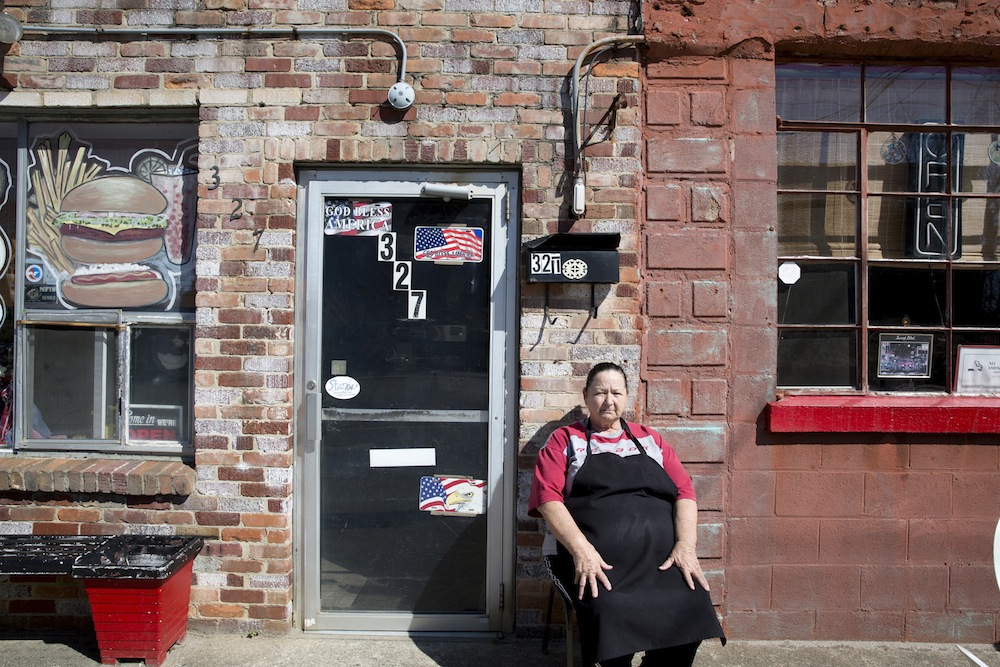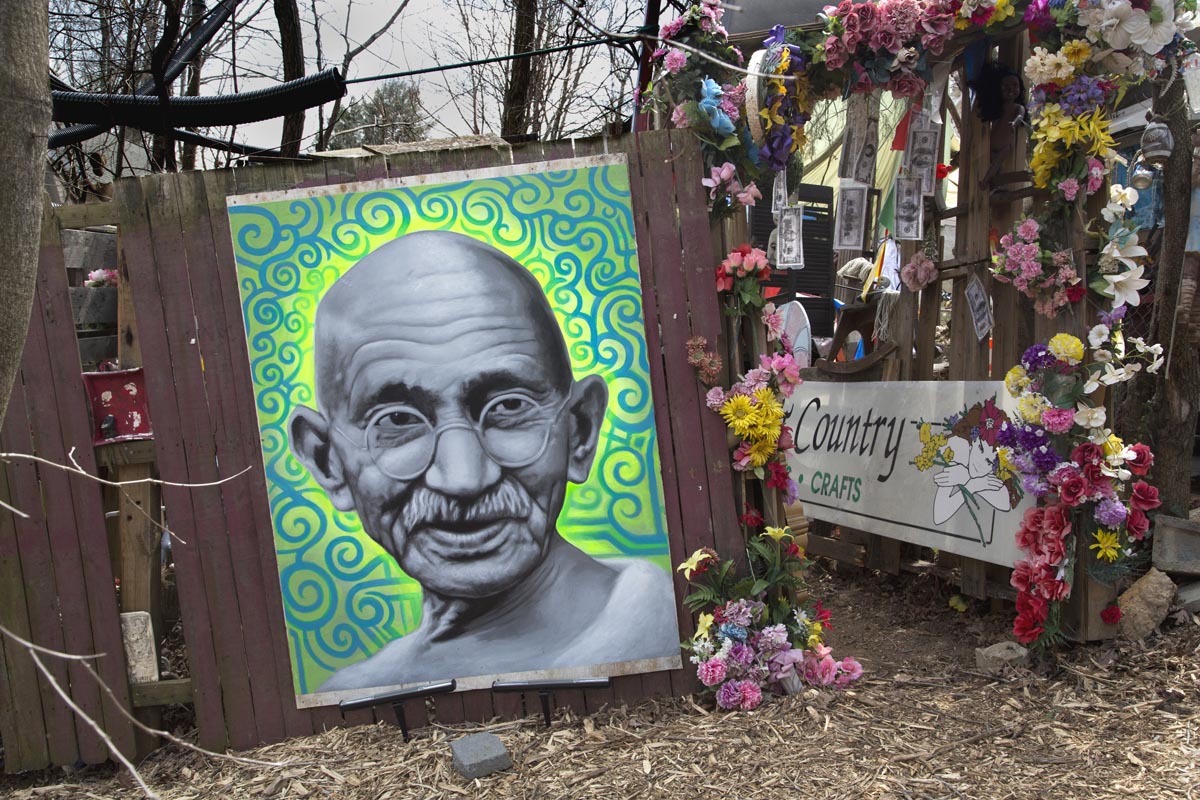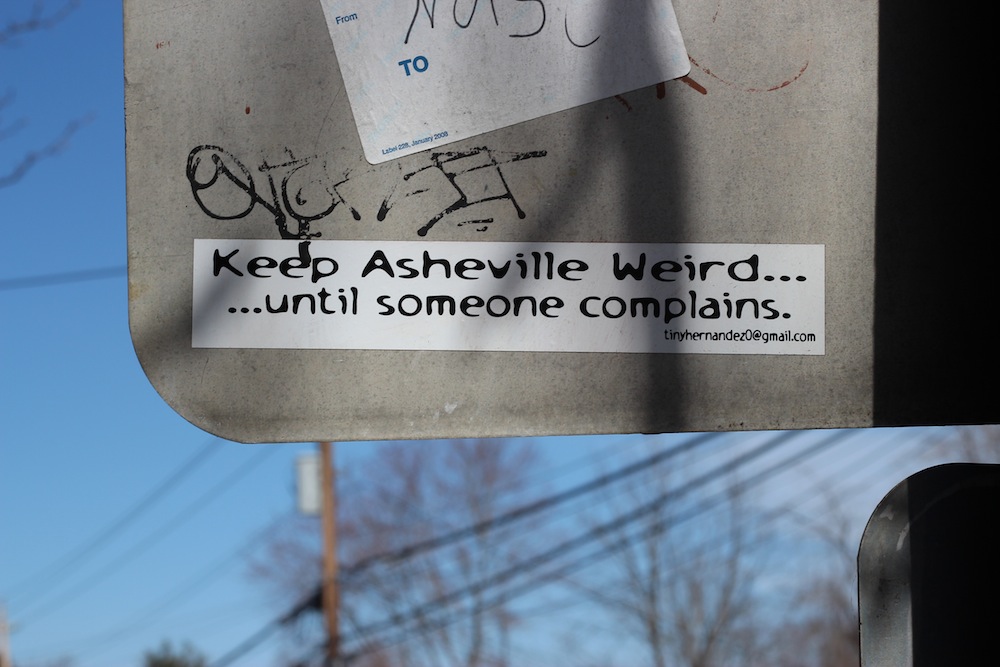It’s walkable, artistic, neighborly, inspiring and it’s not filled with tourists. It has grit and its own unique spirit. It’s not downtown — it’s West Asheville.
Dubbed “Worst Asheville” not so long ago, the area — particularly the Haywood Road corridor — has undergone rapid change, becoming a haven for young families, artists and others seeking something different from both the more tourist-centric downtown and other parts of West Asheville.
“I’ve seen the neighborhood change a lot over the last dozen years,” says Westville Pub owner/manager Drew Smith. “It’s crazy.”
“It’s full of people, full of places to go, and because there are 20 places to choose from, business has never been better,” he continues. “It’s an awesome thing. It’s brighter, safer, more valuable and wholesome.”
Marc McCloud, who owns Orbit DVD, has lived in West Asheville for 17 years. “We bought a house in ’99, because we couldn’t afford to live anywhere else,” he recalls, adding that he’s never regretted moving to West Asheville and opening his business there. After more than a decade, Orbit is having one of its best years ever, he reports.
 |
“It’s been exciting seeing this happen,” says McCloud, though he mourns the demise of some of the funkier establishments. “I don’t want it to be too polished, I guess. I like some grunge in my neighborhood.”
Hosea Jackson owns the Haywood Lounge, which has been in business since 1998. The neighborhood, he says, has “grown really fast. It’s definitely changed for the better. You’re more likely to make a dollar now than before, because there’s so much foot traffic.”
West Asheville, he says, is “not as uppity. … It’s more diverse than downtown, and it’s affordable. Many people can’t afford downtown; you have to really be able to clock in the money.”
Rosanna Mulcahy also welcomes that diversity. She’s opening a used bookstore, Norbury Books & Café, on Haywood Road, with plans for bilingual book readings for children, acoustic shows on the weekends and even drum circles. “I want my store to be a diverse business,” she reveals. “I want to welcome everyone who wants to read — regardless of ethnicity, background or education level.” Mulcahy says she chose West Asheville “because it’s vibrant, and that’s what my business needs to succeed.”
The area’s growth, though, has also brought problems, many residents say: insufficient parking, increased traffic, rising property values and a lack of certain types of non-entertainment-based services.
But for most, the strong sense of community seems to offset those drawbacks.
“It’s a lot more tight-knit,” says Emily Maccombs, who works at Villagers urban homestead supply store. “It feels like a real, old-fashioned neighborhood where neighbors come out to help each other.” The Detroit transplant, who’s planning to move to West Asheville, says, “I think that happens throughout Asheville, but it seems way more pronounced here.”
Trying times
“The first few years we were open, this was a much rougher part of town,” notes Smith. Frequently, Westville staffers had “to get physical with people … and to make sure it was safe for the people who were here that we wanted here. As the years went on, as more places opened up, it cooperatively made the streets safer. Everybody’s got their lights on; there are people walking the roads. There’s nothing nicer than on a Saturday night when I’ll be walking up here from my house and see street traffic, like I’m in a busy metropolis. When there are people walking all over the place, nobody gets in trouble.”
Jackson sounds a similar note. The area, he remembers, “used to have a lot of solicitation going on, but you don’t see that really at all anymore.”

“Mama” of Mama’s Fast Food sits outside the iconic Haywood Road establishment. (Michael Carlebach).
Karen Loughmiller, coordinator of the local library’s West Asheville History Project, says that around the mid-20th century, Asheville felt it needed an improved route west from downtown, and city leaders opted to extend Patton Avenue rather than widening Haywood Road, traditionally the area’s main thoroughfare.
“West Asheville businesses lobbied very hard for Patton Avenue to hook up with Hanover Street and then Haywood Road and bring the traffic through West Asheville proper,” notes Loughmiller. “That did not happen. On Patton Avenue, there was plenty of room for parking, and it was more friendly for automobiles.
“By the time the ’70s and ’80s came along, Patton Avenue was the primary route for traffic,” she continues. “West Asheville didn’t die, but beginning in the ’90s we saw a lot more activity. A lot of people who were retiring, and a lot of younger folks with lots of energy for starting businesses and renovating homes,” began to discover the area.
At least one longtime resident, however, has a somewhat different impression. Luke Atkinson, who’s lived in the neighborhood his entire life, says, “People always talk about the renaissance of West Asheville, but there wasn’t much gap in it for me. In my mind, I can’t see a time when it was real dead.” His father started Luke Atkinson Furniture in 1955, and it’s still a Haywood Road fixture today.
The writing on the wall
For all the change in the neighborhood, it’s still hard to walk a block without seeing amateurish graffiti tags interspersed with more elaborate murals — a problem for the area’s small businesses, says Smith.
“It’s really expensive and tough to deal with; it’s kind of heartbreaking. … I think all the different, vibrant artwork up and down the road is beautiful, but there’s a difference between that and tagging someone’s window.”
That may bother some folks more than others, however. And for some, the graffiti may even be part of the neighborhood’s appeal.
 |
“I moved here from Detroit, so there’s a level of urban aesthetic and appeal that I appreciate a little more than some of the nicer parts of town,” says Mark Craven, who co-owns Asheville Wood & Spoon with his wife, Carrie-Welles. “I like the nicer parts too, but West Asheville has some grit, and some of the things that come along with that — potholes, minor crime — make me feel at home.”
Parking is also a continuing problem for Haywood Road businesses — though it’s a good one to have, argues Smith, because it means people want to be there.
A greater, albeit related, concern is the traffic.
“Traffic is terrible,” says Harvest Records co-owner Mark Capon, though he’s quick to add that he’s been happy in West Asheville for the past decade.
Smith, too, sees the traffic as a problem. “Pedestrian safety is a huge concern,” he points out. “I walk my kids everywhere. People have got to stop at crosswalks: It’s unbelievable how many people don’t. I would love to see Haywood Road become less of a cut-through.”
Ten or 12 years ago, he notes, the cut-through was a great thing for West Asheville, because people driving through saw the area, and that exposure helped businesses gain a toehold. But now, he argues, they don’t need it.
“I wouldn’t mind, in a perfect world, to put a stop sign at every crosswalk,” says Smith. “Make it so brutal for car traffic that people just go a different way. It’s not that we don’t want people here — we do. We just don’t want the cut-through stuff, because it’s dangerous for pedestrian and biking traffic.”
Atkinson, however, says, “It’s always been real busy. There’s definitely a whole lot more bicycles and pedestrians now, but not necessarily more automobile traffic. Ten, 15 years ago, if you backed out of my parking lot, you really only had to look for cars coming, but now you have to be really careful and watch for bicycles and people too.”
The other frequently mentioned concern is rising property values.
“Definitely an issue,” says McCloud of Orbit DVD. “We wouldn’t have been able to fund our store unless our house appreciated over the years, so it helped us, but I don’t want it to get so out of control that people can’t afford to live here.”
Jackson, too, says, “It’s gone up a lot. Especially for homeowners: It’s like double the value since 1998.”
A graph compiled by Mike Figura of Mosaic Community Lifestyle Realty for the Haywood Road area shows a steady decline in the price per square foot from 2008-11 followed by a very sharp increase. Figura, however, says that’s comparable to what’s happened in other parts of Asheville.
Capon feels West Asheville’s issues are really just the typical trends associated with growth.
Smith agrees, saying, “The problems are problems with a growing neighborhood in a vibrant side of town. It needs to be addressed, but if you didn’t have those problems, chances are that nobody’s doing good business.”
No place like home
Challenges aside, nearly everyone seems to agree that what sets West Asheville apart from other areas of the city is what McCloud calls its “true neighborhood feel. The walkability has a lot to do with it; the camaraderie. These houses, even if they’re larger, are basically on quarter-acre lots. You’re not right on top of each other, but there are a lot of people living in a smaller area. You get to know your neighbors. I think that’s ultimately why this side of town is still going great — because that hasn’t really gone away.”
As for his customers, notes McCloud, “A lot of times, it’s a social thing. People aren’t always looking for something specific; they’re in here just to talk. They’ll run into their neighbors, and they like talking to the employees.”
That social aspect extends to the neighborhood as a whole. Walkability creates symbioses between businesses: A person might stop in at West Asheville Lounge and Kitchen, Westville Pub or any number of other places for a bite to eat or a beer and then, because everything’s nearby, walk into a record store or movie store and browse. It’s easy to get caught up in just exploring the various options.
At two points in its history, the area was actually a separate incorporated town, and perhaps some of that independent spirit has carried over to today (see timeline, “Notable Moments”).
 |
“I didn’t choose West Asheville,” says Craven. “West Asheville sort of chose me. I moved here about five years ago, and it was just a matter of circumstance really — I had a job opportunity in Asheville, and I had a friend who lived in West Asheville who had an apartment behind his house available. It kind of seemed like a no-brainer. But in all the time I’ve lived in Asheville, I’ve never wanted to live in any other part of town. I have everything I need here.”
Mandy Leake, who works at WALK, echoes that sentiment. “Everything I need to be happy is within a two-mile radius,” she says. “I live right down the road. There’s a bar right here, there are grocery stores right here, the river is right there.
“Kind of the way bars and restaurants all have regulars, I feel like West Asheville has regulars,” she observes. “You see the same people milling around. It feels like a little community, like back when I was in college and knew everybody.”
Continuity and change
Take a stroll down Haywood Road and you’ll find grocery stores, numerous bars, music venues, record stores, gift shops, antique stores, tattoo parlors, bakeries and breakfast joints.
“Neighborhood,” however, can mean different things to different people, and generational perspectives may vary.
Atkinson, for example, says, “It’s changed a lot. It used to be not so much just restaurants. There was a hardware store, a drugstore, a jewelry store — more retail. That was handy if you lived here: Everything was real close. It was just real handy when there was more variety. I think it would be good if we had more retail up and down Haywood Road. I think we have enough restaurants.”

Ian Wilkinson mural at the Burton Street Community Peace Garden. (Michael Carlebach).
Nonetheless, he continues, “It’s a nice place to be. At one time there was a lot of families with children. Maybe it’s just coming back around — it’s again families with children. I think the population just aged out and now [there are] a lot of young people again, which is a great thing.”
Capon, too, says that while “Haywood has gotten crazier and busier as the years have gone by, it still maintains a strong sense of community and togetherness. I really like where it’s at right now: It has maintained its own identity; it still feels unique from the rest of the city.”
Eric Smythers, co-owner of Second Gear, says, “Initially people got involved here because it was cheap, but prices have spiked. I think it’s the grittiness and the funkiness that keeps West Asheville fun, and if it becomes just another bland suburb, it will be less interesting.”
Still, he continues, “There are enough interesting and different things popping up around here that I think it will keep its own flavor.”
Smith, too, loves the neighborhood flavor. “Some of the most fun times in the world are when we have snowstorms. It is awesome. We had a horse out here last time pulling people on sleds. It was like a ski lodge — there were cross-country skis all over the back; people were pulling sleds home with their beer. You don’t see that downtown: Places just shut down.”
But there’s also a broader, more cyclical pattern at work, Craven maintains. “Neighborhoods come and go: They become popular, they become gentrified, they become sort of passé, whatever. I think the unique part of West Asheville is that it’s at a place on that continuum right now where young people and young families — people with similar tastes and smaller budgets — are still able to make interesting lives happen.”
— Jesse Farthing can be reached at jefarthing@gmail.com.




Before you comment
The comments section is here to provide a platform for civil dialogue on the issues we face together as a local community. Xpress is committed to offering this platform for all voices, but when the tone of the discussion gets nasty or strays off topic, we believe many people choose not to participate. Xpress editors are determined to moderate comments to ensure a constructive interchange is maintained. All comments judged not to be in keeping with the spirit of civil discourse will be removed and repeat violators will be banned. See here for our terms of service. Thank you for being part of this effort to promote respectful discussion.